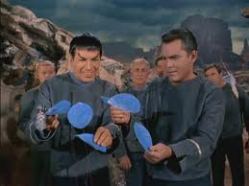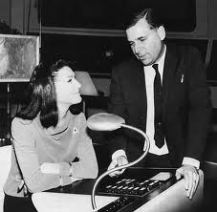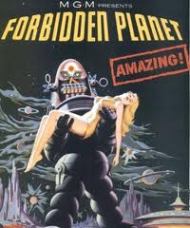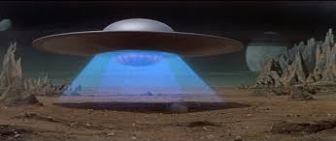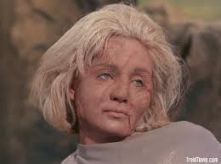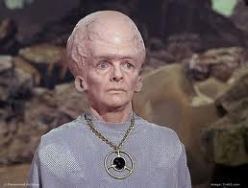Captain’s Blog–Operation Star Trek
In “Captain’s Blog” I want to take up the issue of Star Trek, the Original Series, one episode at a time. After watching Star Trek for nearly a lifetime, what else is there to do but write about it and niggle over ridiculous little details that make up a pretend world full of unreal characters in an impossibly far-fetched setting doing absurd things with earnest? Honestly, what is Star Trek really about? It’s set in the 23rd century, but it’s more 1960s than 2260s. What was Gene Roddenberry and company trying to say with this show when it first aired on NBC in 1966? And what, if anything, do those original 79 episodes say to us now? Questions like these give me the perfect opportunity to watch it all one more time, but this time with a purpose—I want to take a look at each episode, one at a time, and see what makes it tick.
Roddenberry filmed the Star Trek pilot “The Cage” the month I was born in 1964—and so looking into Star Trek is a bit like looking into my own past, yet it’s a past I’ve shared with millions of people at the same time. I am not alone in feeling a connection to the Star Trek universe, but what is the nature of the connection? I am particularly interested in exploring the reasons behind Star Trek’s staying power—why has it been a part of our cultural fabric for the last four decades and counting?
Let’s start by remembering the fact that Star Trek came into the world as a failure. Star Trek’s first pilot episode, “The Cage” fell flat.
Gene Roddenberry, the creator, sometimes writer, and executive producer of the series underwhelmed NBC executives with his vision of a space-faring future as he presented it in “The Cage.” But as in all failures, there is much to learn, for from “The Cage” we learn a great deal about Roddenberry’s vision for what the show would, in the end, become. “The Cage” made its television debut not until 1988 after the Star Trek universe was deeply entrenched in the popular cultural discourse. Still, “The Cage” was not unknown to Star Trek fans. Long before 1988 fans had already seen 50 of the original 63 minute pilot because Roddenberry artfully repurposed “The Cage” as the material for a two-part episode later in season one called “The Menagerie” (1966). He had, it seems, the last laugh on studio executives who rejected his pilot. “The Cage” would remain an inalienable part of the Star Trek universe.
A good start is a good end, as they say, so we start with the beginning, and the beginning is “The Cage;” and thanks to re-mastering and CGI the episode looks better than ever. For those die-hard fans that take special pleasure in the old, beat-up plastic model of the Enterprise amid the cheap special effects space shots from the original pilot, who enjoy the washed out colors and grainy film, I do not share your aesthetic. Roddenberry shot the series on film, which restores quite nicely. “The Cage” now looks and feels like some wonderful old Cadillac from 1965, carefully restored to showroom condition, and here it is right in my garage ready for the road. Let’s go.
 The original “Cage” Enterprise, circa 1965
The original “Cage” Enterprise, circa 1965
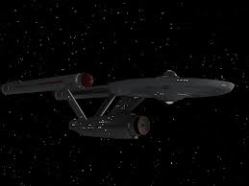
CGI “Cage” Enterprise, circa 2008
In 1964 NASA was still only launching uncrewed rockets that orbited the earth and tested the new Saturn systems designed to take men to the moon. It wouldn’t be until July, 1969 that Neil Armstrong would set foot on the moon—and Star Trek would have already been cancelled! But when Roddenberry made “The Cage” NASA was still in earth orbit. Even so, NASA made so much progress so quickly that, Roddenberry seems to say, that if we kept up the pace of technological innovation in space flight, surely we would be traveling faster than the speed of light by 2265 a.d. I suppose the success of launching heavy lift rocket vehicles into outer space, combined with the heady knowledge that the same rocket technology could carry our hydrogen bombs to any point on the planet, made us feel awfully confident about the future.
Aye, there’s the rub. I do not think Roddenberry was terribly confident about the future, or if he was, his optimism informed only the candy-coated exterior of his vision. Inside the candy shell made up of warp drive and universal peace on earth was the inner, bitter nut of conflict and war that defined life in the Star Trek galaxy. It turns out that some life forms just don’t like humans, or the Federation of Planets, or, for that matter, Jim Kirk. In other words, even though Roddenberry’s predictions about earth technology were brightly optimistic, Star Trek—like a lot of science fiction—uses its vision of the future to explore issues of the present day, like war, freedom, racism, religion, science, love, death, friendship, honor, pride, sex, and power. So, even though we are going warp speed in Roddenberry’s future, in a lot of ways Star Trek suggests we are going no where fast.
I think all this is at work in one way or another in “The Cage.” Perhaps Roddenberry’s first draft did not impress studio execs because it was too much about human frailty, and not enough about how powerful and active our technology would be three hundred years from now. In “The Cage” one Lt. Tyler claims that the Enterprise could destroy “half a continent” but the telepathic Talosians make all of that power irrelevant. As a result, “The Cage” represents Roddenberry’s “ideal man” whose desire for freedom stands for all of humanity. No, Captain Pike resists the temptations of the flesh. No pleasure filled cage for Captain Pike. It is freedom, or death. But how does one achieve this state of perfect will, strength, focus and purpose? According to Roddenberry, Captain Pike must tap into his “primitive” feelings to find his true power. Time and again Star Trek reminds us that to be fully human we need to be fully integrated beings, and not split and in conflict with our feelings, for our feelings make us human. Later in the series Mr. Spock is the symbolic and literal site of the conflict between head and heart. But in “The Cage” Mr. Spock has not yet been imagined as the logical Vulcan battling his half-human emotions. In the pilot Spock smiles, shouts, and behaves in very non-Vulcan ways.
“The Cage” and the Laughing Spock
I think Roddenberry originally wanted to play out the conflict of head versus heart with the Enterprise’s first officer, “Number One,” played by Majel Barrett. Though she only played the part for one episode, her performance hints at the conflict between being a woman with feelings, as well as the ships “most experienced officer” in a male-dominated world. She seems keenly aware of her status as a woman on a man’s bridge. When Pike leaves her out of the landing party, she can barely contain a pout, or when Pike refers to being uncomfortable with women on the bridge, she looks at him, but remains silent. He realizes what he’s said and apologizes and acknowledges that “she’s different.” Again, “Number One” can barely restrain herself from pouting and moping. She’s a woman, dammit. Why doesn’t Captain Pike notice? But Pike is not Kirk. Pike’s great strength in “The Cage” is his ability to resist the female, no matter what color she is.
Gene Roddenberry notices “Number One” circa 1964
Majel Barrett would later marry Gene Rodenberry in 1969, and stay with him until his death. But in 1965, NBC execs didn’t like a female first officer in this or any century. Majel Barret would stay with the cast of Star Trek, but she would have to be demoted to a proper “woman’s” role in order to remain. Even so, Roddenberry would have his way vision of the future his way one way or another, and so rather than women in command positions, he placed an African-American female, an Asian-American and, later, made a Russian the ship’s navigator. The bridge of the Enterprise was diverse, and a symbol of a united Earth.
In 1965 NBC execs thought “The Cage” “too cerebral,” and that the 63 minute drama lacked action. I wonder what were they expecting? It’s hard to know. Still, NBC saw something in the pilot and, in a rare move, asked Roddenberry to try again, and he did. We will take a look at that episode, the first episode of the original series–though it was aired as the fourth episode–“Where No Man Has Gone Before”–in my next Captain’s Blog.
In spite of the fact that the original Star Trek pilot defines the series in numerous ways, “The Cage” has a look and a feel all its own. In it we meet the Enterprise and its crew, but it’s not exactly like the Enterprise from later episodes. The uniforms are different, we see crew members in casual clothing, and the primary and secondary cast members are almost entirely different from the later series—with the exception of Mr. Spock. “The Cage” is Star Trek’s cradle, yet it is not, I would argue, the Star Trek ur-text. That distinction should be placed elsewhere.
Roddenberry had his influences. If I had to guess, I would say that Roddenberry was a fan of Forbidden Planet (1956) staring Leslie Nielsen as the intrepid captain of a flying saucer, one of a fleet of earth space ships cruising the galaxy in the 23rd century. Sound familiar? Forbidden Planet was the first science fiction film to imagine a future in which space ships from earth would be sent on missions across the galaxy, much in the same way naval ships of the line ply the oceans of earth today.
A young Leslie Nielsen plays Captain John J. Adams who commands the United Planets Cruiser C57-D as it travels to Altair IV, some sixteen light years from Earth. Their mission: to discover the fate of an expedition that was sent there twenty years before only to disappear. Adams’ ship arrives at Altair IV and he receives a transmission from a survivor of the lost expedition, one Dr. Edward Morbius—a space faring English professor and the lost expedition’s linguist, played by Walter Pidgeon. Morbius warns Adams to stay away. The captain lands anyway.
Disney animators helped with the special effects.
I think Forbidden Planet must have really moved Gene Roddenberry as a young man, for his first Star Trek pilot seems to me to be an obvious attempt to bring Forbidden Planet-type science fiction to television. The parallels are too obvious to be ignored. Roddenberry’s pilot could easily have been named “Forbidden Planet,” and perhaps would have gained something if it had been.
Both Forbidden Planet and “The Cage,” represent visions of the future in which the military—in naval mode–has left the oceans of earth to set sail on the oceans of interstellar space. Both stories imagine a future in which the inexorable exceptionalism of the human race has lead it to mastering technologies that would allow us to hurl ourselves across vast distances beyond the speed of light. Apparently spreading “our way of life” beyond the stars and to other planets is a given. It’s why we’re here. It’s why we go there. That’s progress!
The parallels between the two stories go beyond the surface. In “The Cage” an interstellar “United Space Ship” called Enterprise intercepts a transmission indicating that an expedition which disappeared 18 years before has crashed on Talos IV. Captain Pike learns that, against all odds, there are survivors in need of rescue. Captain Pike decides to investigate in spite of the fact that his crew is tired and beat up after a previous mission. If you look carefully you’ll see that the Enterprise crew members have bandages on. Spock walks with a limp. They all need a rest, and hospital. Some crew members have died we learn. Pike wants to ignore the distress signal they pick up, but once he hears of survivors, he decides he has to go in for the rescue.
Like Forbidden Planet, Captain Pike and his landing party meet a beautiful and beguiling blond that distracts them, and sets the plot in motion. But let’s not over state things. Motion is a relative term. Both Forbidden Planet and “The Cage” are slow moving, thoughtful, and hail from a different science fction-film tradition. Both stories depend on the audience’s imagination to be gripped by the sheer enormity of the situation. Both narratives are built not on action per se, but on the tension of the situation in which the audience and the characters comes to grips with the fantastic, and other wordly, the unknown. There is a sober, dramatic realism in both stories, as if to say to the audience that in the future these sorts of trips, adventures, sites, and sounds will be par for the course. It’s the new normal, and we’re getting a glimpse of it three hundred years early thanks to Star Trek. Fortunately for the audience, the future is not so different from the present: space ships run a lot like sea ships—with captains, officers, cooks, and crews. With one exception–something called a computer helps to run things.
I think it’s fair to say that “The Cage” has considerably more action in it than Forbidden Planet. As a stand alone piece of science fiction “The Cage” is quite good. Certainly Roddenberry thought so. He imagined that it could be easily expanded into a feature film, and that’s probably true, except Jeffrey Hunter who played Captain Pike had no desire to go on with the project either in film or television. Perhaps that was for the best, for Jeffrey Hunter died in 1969 and would not have lived to enjoy the enormous popularity and staying power of Star Trek. But that begs the question—would there have been a Star Trek as we know it without William Shatner? Perhaps not.
Vina from “The Cage,” good and bad hair days.
Vina, the Talosian human captive, is compelling enough, but unlike the love interest in Forbidden Planet, Captain Pike of the Enterprise realizes very quickly that Vina is bait, and he resists her considerable charms no matter what color she is. The point of all of this, however, is that Vina’s beauty is just an illusion, placed in everyone’s mind by the Talosians. Really she looks like the piteous thing on the right hand side of the images above. According to the story, when her ship crash-landed, every one was killed except for her, and so the Talosians had to save her, put her back together, but tragically, they had “never seen a human being before,” and so they had no model to follow. And so she turned out misshapen, unbalanced and not quite so smooth and sexy as the imaginary Vina. It’s on this last point that I think the whole episode falls apart.
1) The Talosians are humanoid, bipedal creatures whose bodies are, for the most part, symmetrical. They sure must be dumb about such things to think that a bipedal creature would like to have a large, ungainly hump on one side of its body.
2) More importantly, though, if the Talosians are such potent mind-readers, could they not have reached into Vina’s mind and looked at an image of what a human being looks like? Surely they could have, and so one has to wonder: either a) this is a serious gaffe on the part of the writers—gaffes like this are avoidable, but sometimes hard to catch when creating science fiction and trying to keep all the details consistent and believable. Or, b) this is all a part of the Talosian power of illusion. Vina is not misshapen, they only want us to believe she is. If this is so, then perhaps everything everywhere is an illusion—perhaps television is a tool of the Talosians, and perhaps there simply is no “real world” other than the one we mistakenly perceive and call our own.
A Talosian of Talos IV. Big brain, bad medical care.
And perhaps it’s questions like these that upset NBC execs, and so they sent Roddenberry back to the drawing board. Don’t make us think so much! This is TV for Christ’s sake! Give us action, ray guns, battles to the death, good guys and bad guys. Make it clear. We do not need any more television that questions the nature of mind control.
What ever its flaws, “The Cage” is about more than the speculative future it presents. Even the evil Talosian zookeepers on Talos IV appear not so evil by the end of the episode. They release the humans once they realize holding them is futile. They even reward their prize specimen with an illusion all her own, a virtual Pike that she can love and talk to, and, well, it all gets very complicated because he’s not really there, but no matter. As the Talosians say, “may your real life be as pleasant as Vina’s imaginary one.”
“The Cage” is, in many ways, Roddenberry at his best—the pilot is an exploration about what makes us human—and in this case he is answering back the claims of Forbidden Planet. In that story, the technology of the forbidden planet unleashes “monsters from the id,” and this primitive “id” which is supposedly inside all of us will, if unleashed, seek to destroy, murder and otherwise make life unbearable. But for Roddenberry, our “primitive emotions” are not so destructive as they are humanizing, necessary, and the source of our strength, our desire for freedom, and our need to push the boundaries of our existence. And so in many ways “The Cage” is tried and true Star Trek right from the start: Captain Pike saves the day because he taps into his “primitive” emotions. Rage and hate become a defense against the telepathic manipulations of his jailors. It is because of his “primitive” emotions that he is able to capture one of the aliens holding him and two female crew members. Once free, they make it to the surface of the planet. At this point, it’s interesting that “Number One” sets her laser gun (not yet a phaser) on overload in the final moments of the episode; in those final moments she becomes a suicide bomber without even looking at her captain for approval. She knows, apparently, that he as well as she would rather die in a fiery explosion than live as slaves, even comfortable ones. I am not sure 1960s television had such a female character on any other show, but here she was, the woman of the future–but don’t blink or you’ll miss her. As I mentioned, in future episodes Roddenberry demoted Majel Barret from the ship’s first officer to the ship’s Nurse Chapel. Mr. Spock—no longer laughing—became first officer in her place. Ah, much better say the executives. Engage.


